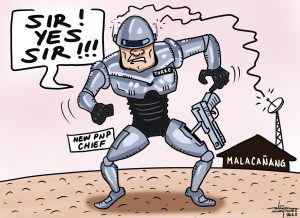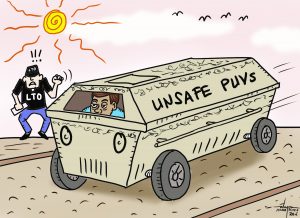Some people — the street smart and the greedy kind — like their ilk outside of the country, never run out of innovative ways to take advantage of the gullibility of others.
And they know exactly who are their would-be victims and the manner with which they have to approach them without much effort.
We are referring to the ingenuity of some of us Filipinos in making others believe that other than hard work where improving their lives is far-fetched because of the characteristic starvation wages in the country; or of engaging in business that is likely to fold up because of small capital and lack of expertise, there are near effortless investing of their little money yet earning very high returns in so short a time.
These are the current talk of the town, the no sweat investing of one’s money in non-existent business ventures but in only one or three or six months will yield interest that multiplies the amount cashed out as much as double to triple.
There can be no iota of doubt that these reported high-yield investment businesses are variants – even improvements — of the so-called Ponzi and the pyramid schemes of accumulating money by a person or group with hardly any authority from government regulators to engage in the business they are offering to the public.
We say improvements because one investment group even registered with government regulators as a religious ministry and shrewdly convinced people to turn in their money as donation to the organization complete with duly notarized Deed of Donation.
So, whatever happens to the investment venture all access for legal remedies against its officials are already closed and thoroughly sealed even as the exits for their way out of the regulators’ reach are all wide open. Of course if the unlucky investors are willing to shed more money for potentially protracted court litigations that would be another interesting story.
Yes, there are those who claim to be officials of double-triple-your-money ventures that have shown some documents that supposedly support claims of legality in the operations. However, based on the accounts of those who were approached but wanted to look into the ventures’ documents, they found no provisions that authorize the supposed business organizations to engage in taking direct cash investments or selling security papers like shares of stocks of publicly-listed corporations.
Government authorities and regulators are already well aware of the big possibility that the “get-rich-quick” ventures prevailing in the two neighboring regions in Mindanao are fraudulent schemes, or scams in crime parlance. And they know these are feeding on the vulnerability of certain sectors of the population, including the people’s religiosity.
We do not know if it is fortunate or unfortunate that the most prevalent and widely patronized “get-rich-quick” schemes are operating in the Davao and its neighboring Caraga and Cotabato Regions.
Some argue that it is fortunate because a good number of investors are giving personal testimony they have already improved their status in life; that they are now regularly getting the returns of their investments every “pay-out” schedule.
But there are more discerning residents and local government officials who believe that with the investment methodology having all the attributes of a Ponzi and pyramiding schemes, eventually the flow of new investors will recede and money will bottom out. And when investments dry up there will be not enough money around when pay-out time comes.
In Davao City Mayor Sara Duterte-Carpio has been emphatic on her warning for any and all of the known “investment” firms not to operate in her area of jurisdiction. And she has strict instructions to the police and barangay officials to report to her if there are agents of the “investment” companies soliciting investors. We however, learned from some very reliable sources that agents of these schemers are recruiting investors in Calinan even in right inside the cockpit.
But it is a different story in other provinces and cities where there are known operations of the Ponzi style investment ventures. In Davao del Sur the governor prefers a “hands-off” policy. From what we have heard and seen in radio and television interviews, and read in local newspapers, the mayors of the towns of the southern Davao Province are also adopting a stand similar to that of their provincial chief executive.
The same position is also prevailing among the top provincial officials in Davao del Norte as well as in the City of Tagum. Some residents in that place who claim they are big-time investors in one of the more popular Ponzi-type businesses are insisting most of their top officials have put much bigger amount in the business.
In Compostela Valley Province, a recently elected congressman is even advocating for the legalization of all Ponzi and other pyramiding businesses.
Apparently these local government officials may be one in believing that those who are into the “get-rich-quick” ventures are only exercising one of the freedoms guaranteed to every Filipino by the Constitution – that is, the freedom to engage in any business enterprise.
Probably, this could also be the main reason why the Department of Interior and Local Governments (DILG) has been unable to have the Securities and Exchange Commission (SEC) Cease and Desist Order (CDO) issued against the operation of one such Ponzi or pyramid schemes implemented.
And how will the DILG execute such a CDO when only one mayor is openly prohibiting the operation of the Ponzi/pyramid businesses in her city? All the other LGU executives would rather tolerate them.
The Philippine National Police – well, they have no basis to run after any of the Ponzi type firms or its operators. Nobody is filing any case against them, they claim. Some of them were victims of a pyramiding scheme orchestrated by their own officials in General Santos City.
Besides, even the hundreds of thousands of “investors” who have forked their money from as small as P1,000 to as large as several millions of pesos are loudly complaining against the efforts of some sectors including the government to stop them from investing. They argue that the non-investors and regulators have no right to bar them from doing so. After all “it is our money, not yours,” they say quite forcefully if only to drive home their point that they are simply helping themselves get rich. So what proposition from any unwelcomed financial advisors can top that argument of those who believe they already are enjoying or soon to start reaping the fruit of their investment.
Indeed the money the “investors” in the various Ponzi and pyramid schemes proliferating in the Davao, Caraga, and Cotabato regions are theirs. Whether they got it from their savings or from proceeds of loans or sale of personal or real properties, still the money is theirs. So, what right really do other people have to stop them from investing?
As journalist though we feel we have some obligations to help people make wise decision in sinking their hard-earned cash in business ventures that we believe “too good to be true, therefore it is not true.”
May be we would not be begrudged if we share some information on how the Ponzi and pyramiding fraudulent business schemes had evolved.
With did our personal research on the Ponzi and pyramiding schemes. But we had our data augmented with the help of our Managing Editor Carmelito Q. Francisco.
What is a Ponzi scheme?
A quick visit at the internet gives us the following information:
A Ponzi scheme is a fraudulent investing scam promising high rates of return.The Ponzi scheme generates returns for early investors by acquiring new investors. It is similar as the pyramid scheme in the sense that both are based on using new investors’ funds to pay the earlier backers. Both the Ponzi and pyramid schemes eventually bottom out when the flood of new investors dries up and there isn’t enough money to go around. It is at this point that the schemes’ fraudulent means unravel.
Companies or groups that engage in a Ponzi or pyramiding scheme focus all of their energy into attracting new clients to make investments.
Key takeaways
Both Ponzi and pyramid schemes generate returns for older investors by acquiring new investors, who are promised a large profits at little or no risk.
Both fraudulent arrangements are premised on using new investors’ funds to pay the earlier backers.
Companies that engage in either Ponzi or pyramid scheme focus their energy into attracting new investors.
The new funds that will come in are used to pay original investors their returns, marked as a profit from legitimate transactions purportedly brokered by the companies. Ponzi and pyramid schemes rely on a constant flow of new investments to continue to provide returns to older investors. When this flow runs out, the schemes fall apart.
Origin of the Ponzi scheme
The Ponzi scheme is named after one Charles Ponzi, who orchestrated it in 1919. The postal service at that time had developed international reply coupons that allowed a sender to pre-purchase postage and include it in their correspondence. The receiver would take the coupon to a local post office and exchange it for the priority airmail postage stamps needed to send a reply.
The constant fluctuation of postage prices meant that it was common for stamps to be more expensive in one country than another. Ponce hired agents to purchase cheap international reply coupons in other countries and send them to him. He would then exchange those coupons for stamps that were more expensive than the coupon was originally purchased for. The stamps were then sold at a profit.
This type of exchange known in financial parlance as arbitrage is not an illegal practice. But Ponzi became greedy and expanded his profit taking efforts.
He put up a business called Securities Exchange Company. He promised returns of 50 % in 45 days or 100 % in 90 days. Due to his success in the postage stamps scheme, investors were immediately attracted. But instead of actually investing the money, Ponzi just redistributed it and told the investors their investments made a profit. The scheme lasted until August of 1920. Ponzi’s racket ended when the Boston Post newspaper investigated the operation of Ponzi’s Securities Exchange Company. He was arrested by Federal authorities on August 12, 1920.
Ponzi and pyramid schemes red flags
Regardless of the methodologies, approaches and technologies used by the Ponzi or the pyramid scheme, most share identical characteristics:
A guaranteed promise of high return with little risk;
Consistent flow of returns regardless of market conditions;
Investments that have not been registered with the Securities and Exchange Commission (SEC);
Investment strategies that are secret or described as too complex to explain;
Clients not allowed to view official paperwork for their investment; and
Clients end up facing serious difficulties recovering their money, or being totally unable to get back their investment.
Now, given the preceding red flags, should people be surprised to learn that an executive of one of the Ponzi type “get-rich-quick” investment schemes — or simply scam –in the Davao region was able to purchase a P14 million house in a government subdivision five kilometers away from the city proper without any semblance of haggling with the seller to lower the selling price?


